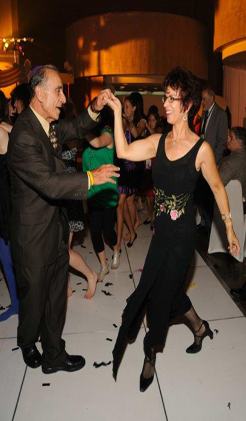 We all have our favorite exercises. Mine have always been dancing, biking and running. Also, I still like to jump, when my knees are strong. I now know how to jump correctly: by softly landing on bent knees. Last week, I made four attempts at a cartwheel and did one in my gym in front of my 88-year-old client, who used to do gymnastics in her younger days. But honestly, if I only performed just one of my favorite exercises, I wouldn’t be able to move as well as I do, bend as easily to pull weeds or plant in my garden, or carry equipment, when I teach. Even my 80-year-old husband, Ralph, is in the shape he is, because he has been exercising in one form or another all his life, beginning as a gymnast at 14-years-old and a City Champion by 17. Ralph still lifts weights and swims for a mile three times a week. He is a perfect role model for any of my 50 years and over clients.
We all have our favorite exercises. Mine have always been dancing, biking and running. Also, I still like to jump, when my knees are strong. I now know how to jump correctly: by softly landing on bent knees. Last week, I made four attempts at a cartwheel and did one in my gym in front of my 88-year-old client, who used to do gymnastics in her younger days. But honestly, if I only performed just one of my favorite exercises, I wouldn’t be able to move as well as I do, bend as easily to pull weeds or plant in my garden, or carry equipment, when I teach. Even my 80-year-old husband, Ralph, is in the shape he is, because he has been exercising in one form or another all his life, beginning as a gymnast at 14-years-old and a City Champion by 17. Ralph still lifts weights and swims for a mile three times a week. He is a perfect role model for any of my 50 years and over clients.
What can you do to stay in shape?
Exercise more! Increased physical activity can lead to a longer life and improved health:
- Exercise helps prevent heart disease and many other health problems.
- Exercise builds strength, gives you more energy and can help reduce stress.
- Exercise is a good way to curb your appetite and burn calories.
Who should exercise more?
Increased physical activity can benefit almost anyone. Most people can begin gradual and moderate exercise on their own. If you think there is a reason you may not be able to exercise safely, talk with your doctor before beginning a new exercise program. In particular, your doctor needs to know if:
- You have heart trouble, high blood pressure or arthritis.
- You often feel dizzy or have chest pains.
What kind of exercise should I do?
Exercises that increase your heart rate and move large muscles (such as the muscles in your legs and arms) are best. Choose an activity that you enjoy. Start slowly and gradually increase, as your body becomes used to it. For example, walking is simple and does not require special equipment. Other good exercises include swimming, biking and dancing.
How long should I exercise?
Start off exercising three or more times a week for 20 minutes and work up to four to six times a week, for at least 30 minutes. This can include several short bouts of activity in a day. Exercising during a lunch break or on your way to do errands may help you add physical activity to a busy schedule. Also, exercising with a friend or family member can help make it fun; plus, having a partner to encourage you can help you stick with it.
Is there anything I should do before and after I exercise?
- You should start an exercise session with a gradual warm-up period. For example, begin walking slowly and then pick up the pace.
- After you are finished exercising, cool down for five to 10 minutes. Again, stretch your muscles and let your heart rate slow down gradually. You can use the same stretches that you used in the warm-up period.
How hard do I have to exercise?
Even small amounts of exercise to optimize your aerobic fitness are best. Start with an activity you can do comfortably. As you become more used to exercising, try to keep your heart rate at about 60% to 85% of your “maximum heart rate.”
To reach your maximum heart rate, subtract your age (in years) from 220. Now, to calculate your target heart rate, multiply that number by 0.60 or 0.85. For example, if you are 40 years of age, subtract 40 from 220, which would give you a maximum heart rate of 180 (220 – 40 = 180). Then, multiply this number by both 0.60 and 0.85, which gives you the range.
When you first start your exercise program, you may want to use the lower number (180 x 0.60 = 108)as your target heart rate. Then, as your conditioning gradually increases, you may want to use the higher number (180 x 0.85 = 153) as your target heart rate. Check your pulse, use a heart rate monitor or one of your other favorite devices.
How do I avoid injuring myself?
The safest way to keep from injuring yourself during exercise is to avoid trying to do too much too soon. Start with an activity that is fairly easy for you, such as walking. Do it for a few minutes a day or several times a day. Then, slowly increase the time and level of activity. For example, increase how fast you walk over several weeks. If you feel tired or sore, ease up somewhat on the level of exercise, or take a day off to rest. Try not to give up entirely, even if you don’t feel great right away! Talk with your doctor, if you have questions or think that you may have injured yourself seriously.
What about strength training?
Most kinds of exercise will help both your heart and your other muscles. Resistance training is exercise that develops the strength and endurance of large muscle groups. Weight lifting is an example of this type of exercise. Exercise machines can also provide resistance training. Your doctor or a trainer at a gym can give you more information about exercising safely with weights, bands or machines.
Simply put, I urge you to start somewhere – perhaps modify something you did when you were younger. Put on some music and go. Call Lori Michiel Fitness at 818-620-1442 or email us through our contact form to embark on your fitness journey – it will almost certainly be anything but routine!
